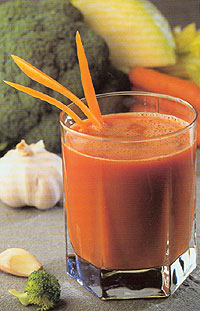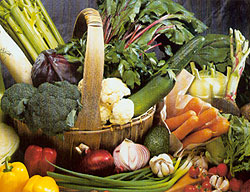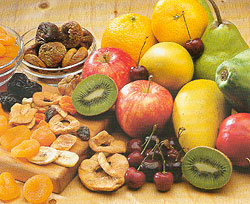|
Why Juice?
Today after decades of declining health and
rapid ageing, the promise of living foods is once again gaining
international attention simply for its natural healing properties
and energy source. Living foods are an effective way of helping
our bodies heal themselves. A healthy body is a body with
healthy enzymes.
Living foods, fresh and raw, are the foundation of any healthy
eating program, and have amazing healing and rejuvenating
properties.
Living foods...
- improve immunity
- increase energy
- cleanse blood
- promote vitality
- manage weight
- nourish organs
- detoxify and maintain cellular structure
 The
major benefits of a living food diet are that vital enzymes
and nutrients remain intact and are able to be utilised by
the body. When food is heated above 44.C, most of these enzymes
and nutrients are destroyed. Enzymes are involved in every
process of the body. The complete regulatory system in the
body depends upon enzymes and suffers from their depletion.
All fresh living foods contain these vital enzymes. The
major benefits of a living food diet are that vital enzymes
and nutrients remain intact and are able to be utilised by
the body. When food is heated above 44.C, most of these enzymes
and nutrients are destroyed. Enzymes are involved in every
process of the body. The complete regulatory system in the
body depends upon enzymes and suffers from their depletion.
All fresh living foods contain these vital enzymes.
To maintain the living properties of our foods, they need
to be kept fresh and raw. Storage, heat, oxidation, preservatives
and pesticides have a strong influence on enzyme activity,
reducing the health benefits to our bodies. According to medical
research, enzyme shortages are commonly seen in a number of
chronic illnesses such as allergies, obesity, heart disease
as well as in ageing and certain types of cancer.
The body consists of trillions of living cells, these in
turn need living cells to feed them, which can only be found
in living foods, best assimilated as juice, or in other liquid
forms.
Juicing is a speedy way of making the body alkaline, (most
modern foods and drinks are acid forming) and most important,
a more acid system is more likely to be prone to inflammatory
conditions and disease generally as is a oxygen depleted system.
Many caterers use the Champion Juicer in their businesses,
for both juices and icecreams as they are a heavy duty machine.
The Champion Juicer can be seen in markets all over Australia
and New Zealand making delicious frozen fruit icecreams. In
addition to extracting juices the unit can homogenise , making
purees, baby foods, fruit sauces, nut butters, sorbets and
icecreams - delicious soft serves of homemade icecream and
frozen fruits. Makes natural food preparation more interesting
for those in restricted diets, knowing the food content. There
is only one attachment for the Champion Juicer - a Grain Mill
for grinding flour from coarse grains, rice, barley, wheat,
oats and corn, or grinding coffee beans.
Click
here to order the Champion Juicer now.
The Benefits
of Juicing
A diet high in fruits and vegetables will prevent or cure
a wide range of ailments.
Breast cancer, cancer of the colon, esophagus, stomach, lungs,
ovaries, and rectum - pick and ailment these days, it seems,
and researchers somewhere are searching for chemicals in plants
that will prevent them, or offer a cure. These plant chemicals,
known as phytochemicals, are the cutting edge of nutritional
research because they hold the keys to preventing some of
our most deadly diseases, such as cancer and heart disease,
as well as some of our most common, like asthma, arthritis,
and allergies.
 In
some ways, this isn't news. For years, epidemiological studies
that compare disease states and diet in large populations
of people have already been bearing out the value of a diet
high in fruits and vegetables. Such studies, which have been
done in Africa, China, the Mediterranean, Russia, and elsewhere
have shown that in cultures where the diet consists of fruits
and vegetables, making it high in both carbohydrates and fiber,
a number of diseases that afflict North Americans simply don't
exist. For example, during more than 30 years of study, British
researchers working in Africa didn't find a single case of
such common ailments as diverticulitis, hernia, cancer of
the colon, or cancer of the prostate. The only reason that
they could attribute to the lack of these diseases: differences
in diet. In
some ways, this isn't news. For years, epidemiological studies
that compare disease states and diet in large populations
of people have already been bearing out the value of a diet
high in fruits and vegetables. Such studies, which have been
done in Africa, China, the Mediterranean, Russia, and elsewhere
have shown that in cultures where the diet consists of fruits
and vegetables, making it high in both carbohydrates and fiber,
a number of diseases that afflict North Americans simply don't
exist. For example, during more than 30 years of study, British
researchers working in Africa didn't find a single case of
such common ailments as diverticulitis, hernia, cancer of
the colon, or cancer of the prostate. The only reason that
they could attribute to the lack of these diseases: differences
in diet.
But these studies (more than 150 have been done in the last
decade) don't really prove that it is diet that makes the
health difference There are simply too many other factors
that may influence health to make the studies conclusive.
Is, for example, the lack of disease because of the subjects
diet or, instead, is it because they live in a relatively
unpolluted environment? If it is diet, which part of their
diet, specifically, is making the difference?
There are the questions that led researchers at the National
Cancer Institute, at the department of Agriculture, and elsewhere,
to begin looking for specific substances in foods that could
be providing protection against disease. In the process, they
have found quite a few.
A tomato, along with vitamin C, vitamin A, and several minerals,
also has 10,000 other chemicals in it, most which researchers
are trying to isolate, identify, and study.
The phytochemicals that researchers have uncovered are changing
the way we think about food, especially fruits and vegetables.
for example, broccoli contains a substance that may prevent
- even cure - breast cancer. Citrus fruits have substances
that make it easier for your body to remove carcinogens, thus
decreasing the chance of contracting cancer. Grapes contain
a phytochemical that appears to protect each cells' DNA from
damage. Similarly, a number of green vegetables contain phytochemicals
that appear to offer protection against cancer-causing substances.
The list goes on and on: bok choy, broccoli, Brussel sprouts,
cabbage, cauliflower, carrots, collards, kale, kohlrabi, mustard
greens, rutabaga, turnip greens, red beets, peppers, garlic,
onions, leeks, and chives are but a few of the vegetables
that appear to have cancer-preventing phytochemicals.
The problem, though, is that most of us don't eat enough
fruits and vegetables to reap the benefits they offer. For
example, although the National Cancer institute recommends
five servings of vegetables and three of fruits each day,
the truth is this: The average American eats only 1 1/2 servings
of vegetables and, on average, no fruit on any given day.
 Maybe
the business men and women who frequent trendy juice bars,
the company that delivers carrot juice, and the grocery stores
that are beginning to carry fresh fruits and vegetable juices
are on to something. Possibly, juicing could provide the answer
to fixing our fruit and vegetable deficient diets. Maybe
the business men and women who frequent trendy juice bars,
the company that delivers carrot juice, and the grocery stores
that are beginning to carry fresh fruits and vegetable juices
are on to something. Possibly, juicing could provide the answer
to fixing our fruit and vegetable deficient diets.
Really, it isn't a new idea. If you study the traditions
of most juicing programs, you discover that the vegetables
being studied at various facilities around the country are
often the same vegetables that have been juiced for years.
Collard greens, kale, kohlrabi, mustard greens, rutabaga,
peppers, carrots, and cabbage are not only vegetables being
studied for their phytochemical content, they are also the
vegetables that are most commonly juiced. Not only are researchers
looking into the cancer-prevention capabilities of citrus
fruits, grapes, and apples, these are also the fruits that
we most often associate with fruit juicing.
All of this raises the question, what else is there in the
wisdom of juice therapy that, up until now, have traditional
nutritional research overlooked or ignored? For example, juice
programs often tout the value of adding chlorophyll to your
daily diet. Chlorophyll, a substance found exclusively in
plants, has a structure similar to hemoglobin, the substance
in blood that is responsible for transporting oxygen. During
the 1940s, researchers found that consuming chlorophyll enhances
the body's ability to produce hemoglobin, thus improving the
efficiency of oxygen transport. Since the 1940s, however,
there has been little research into the value of chlorophyll.
Or, for another example, consider fresh juice's ability to
deliver another important group of nutrients, know as enzymes.
Enzymes are your body's work force. Acting as catalysts in
hundreds of thousands of chemical reactions that take place
throughout the body, enzymes are essential for digestion and
absorption of food, for conversion of food stuffs into body
tissue, and for the production of energy at the cellular level.
In fact, enzymes are critical for most of the metabolic activities
taking place in your body every second of every day.
Fresh juices are a tremendous source of enzymes. In fact,
the "freshness" of juice is one of their key features,
because enzymes are destroyed by heat. When you eat cooked
foods, whether its meal, grains, fruits, or vegetables, if
the food is cooked at temperatures above 114 degrees, the
enzymes have been destroyed by the heat. Since fruits and
vegetables are juiced raw, the enzymes are still viable when
you drink the juice.
 Coincidentally,
many of the phytochemicals that nutritional researchers are
focusing their attention on are either enzymes, or more often,
they are substances that help build or activate enzymes that
play essential roles in protecting cells from damage. Coincidentally,
many of the phytochemicals that nutritional researchers are
focusing their attention on are either enzymes, or more often,
they are substances that help build or activate enzymes that
play essential roles in protecting cells from damage.
In addition, fruit and vegetable juices are good sources
of the traditional nutrients. Citrus fruits (grapefruit, oranges,
etc.) provide healthy portions of vitamin C. Carrot juice
contains large quantities of vitamin A, in the form of beta
carotene. A number of green juices are a good source of vitamin
E. Fruit juices are a good source of essential minerals like
iron, copper, potassium, sodium, iodine, and magnesium, which
are bound by the plant in a form that is most easily assimilated
during digestion.
Plus, since juicing removes the indigestible fiber, these
nutrients are available to the body in much larger quantities
than if the piece of fruit or vegetable was eaten whole. For
example, because many of the nutrients are trapped in the
fiber, when you eat a raw carrot, you are only able to assimilate
about 1% of the available beta carotene. When a carrot is
juiced, removing the fiber, nearly 100% of the beta carotene
can be assimilated.
Finally, fruits and vegetables provide one more substance
that is absolutely essential for good health - water. More
than 65% of most of the cells in the human body are made of
water, and in some tissues, for example the brain, the cells
can be made up of as much as 80% water. Water is absolutely
essential for good health, yet most people don't consume enough
water each day. Plus, many of the fluids we do drink, coffee,
tea, soft drinks, alcoholic beverages and artificially flavoured
drinks each contain substances that require extra water for
your body to eliminate. Fruit and vegetable juices are free
of these unneeded substances and are full of pure, clean water.
The remaining question is how far will the trend go? So far,
the National Cancer Institutes attempts to promote the health
benefits for fruits and vegetables have only affected a relatively
small segment of society. But, as more and more is written
about the long-term health benefits of fruits and vegetables,
as increasing numbers of people learn about the possibility
of preventing and curing cancer, heart disease, arthritis,
and a host of other diseases by making dietary changes, the
fruit and vegetables trend and the popularity of juicing will
continue to grow. Who knows, maybe someday it will be hard
to find a seat during happy hour at your local juice bar.
Click
here to order the Champion Juicer now.
|

